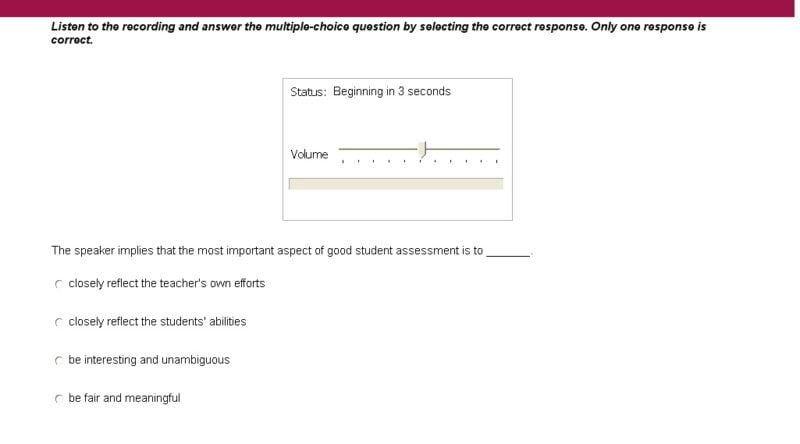The Pearson Test of English (PTE) Academic is a widely recognized English proficiency exam, and its Listening section plays a crucial role in assessing a candidate’s ability to comprehend spoken English. Among the various tasks in the Listening section, Multiple Choice, Single Answer (MCSA) questions can seem deceptively simple. However, success in this task of the PTE test requires both sharp listening skills and strategic answering techniques.

In this blog post, we’ll break down everything you need to know about this question type, provide step-by-step strategies, and offer tips to maximize your score.
What Are Multiple Choice, Single Answer Questions in PTE Listening?
In the Multiple Choice, Single Answer questions, you’ll hear an audio recording (which could be a conversation, monologue, or presentation) and then see a question with several answer options. Your job is to select the ONE correct answer based on the content of the recording.
Key characteristics of this task:
1. The audio will only play once—so you must pay close attention.
2. The question may focus on the main idea, specific details, the speaker’s opinion, or the purpose of the audio.
3. Time management is important because this task is just one of several in the Listening section.
Why Are These Questions Important?
While the Multiple Choice, Single Answer task carries less weight compared to some other tasks in terms of scoring, it helps improve your overall listening and comprehension skills. Additionally, this task mirrors real-life scenarios, such as selecting the correct information in meetings, lectures, or presentations, making it highly practical.

Step-by-Step Strategy for MCSA Questions
Step 1: Understand the Question Before Listening
• Before the audio begins, you’ll see the question on the screen along with the answer options.
• Read the question carefully to determine what is being asked. Is it about the main idea, a specific detail, or an implied meaning?
• Skim through the answer choices to get an idea of what to listen for.
Step 2: Focus on the Big Picture
• As the audio begins, concentrate on understanding the overall meaning. What is the speaker talking about? What is the tone or purpose?
• Avoid fixating on individual words or phrases. Instead, try to grasp the key points and main ideas.
Step 3: Take Effective Notes
• Use shorthand or symbols to jot down the key points while listening. Focus on:
• Names, dates, or numbers.
• Keywords or phrases that summarize the main idea.
• Contrasts (e.g., “however,” “but”) and emphases (e.g., “most importantly,” “significant”).
Step 4: Eliminate Distractors
• After listening, carefully analyze the options. Eliminate choices that are:
• Too broad: They might be loosely related to the topic but don’t answer the question.
• Too specific: They might focus on a minor detail rather than the main idea.
• Factually incorrect: They contradict the audio.
Step 5: Choose the Best Answer
• Out of the remaining options, pick the one that aligns most closely with the key ideas you noted during the recording.
Common Pitfalls and How to Avoid Them
1. Not Reading the Question Properly
• Many candidates skim the question and jump straight into the audio. This can cause confusion about what to focus on. Always clarify what the question is asking.
2. Getting Distracted by Distractors
• Test makers often include plausible-sounding incorrect answers. Stay calm and rely on your notes and comprehension to avoid being misled.
3. Overthinking the Answer Choices
• Don’t second-guess yourself too much. If you’ve narrowed down the options and one clearly stands out, trust your instincts.
4. Missing the Main Idea
• Candidates sometimes focus too much on isolated details. Always remember that most MCSA questions require understanding the big picture of the audio.

Tips to Excel in MCSA Questions
1. Practice Active Listening
• Listen to English podcasts, TED Talks, or audiobooks. Try to summarize the main idea after listening.
2. Work on Note-Taking Skills
• Develop a shorthand system that helps you jot down key points quickly. Practice this while listening to sample audios.
3. Build Vocabulary and Contextual Understanding
• A rich vocabulary and familiarity with different accents (British, Australian, American) can help you understand the nuances in the audio.
4. Use the Process of Elimination
• Even if you’re unsure of the answer, eliminate clearly wrong options to improve your chances of guessing correctly.
5. Practice with Sample Questions
• Use official PTE practice materials or mock tests to get a feel for the question type. Review your answers to understand your mistakes.
6. Stay Calm and Focused
• Anxiety can make it hard to concentrate. Take deep breaths before the audio starts and focus on the task at hand.
Sample Question Walkthrough
Here’s an example to put the strategy into practice:
Audio Excerpt (Summary): A speaker discusses the benefits of urban green spaces, such as improved air quality, reduced stress, and opportunities for exercise. The speaker also mentions the challenges, including maintenance costs and limited availability of land in cities.
Question: What is the main idea of the talk?
A. Urban green spaces help reduce stress and improve health.
B. Urban green spaces are costly and difficult to maintain.
C. Urban green spaces have both benefits and challenges.
D. Cities should prioritize building urban green spaces.
Correct Answer: C
• The speaker mentions both the benefits and challenges, making C the best choice. Options A and B focus on specific points, while D introduces an opinion that is not directly stated in the audio.
Final Thoughts
The Multiple Choice, Single Answer questions in the PTE Listening section may seem straightforward, but they test your ability to comprehend spoken English, identify main ideas, and filter out irrelevant information. By practicing active listening, improving note-taking skills, and mastering the process of elimination, you can tackle these questions confidently.
Remember, success in this task is not just about understanding English—it’s about applying strategies to interpret and respond effectively. Practice regularly, review your mistakes, and stay focused during the test.
Gaurav Thapa is an experienced instructor of English as a Foreign Language. He has eight years of experience teaching IELTS and PTE.